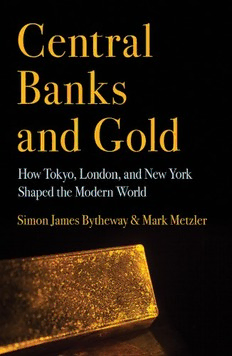
Central Banks and Gold: How Tokyo, London, and New York Shaped the Modern World PDF
Preview Central Banks and Gold: How Tokyo, London, and New York Shaped the Modern World
Central Banks and Gold A volume in the series Cornell Studies in Money Edited by Eric Helleiner and Jonathan Kirshner A list of titles in this series is available at www.cornellpress.cornell.edu. Central Banks and Gold How Tokyo, London, and New York Shaped the Modern World Simon James Bytheway and Mark Metzler Cornell University Press Ithaca and London Copyright © 2016 by Cornell University All rights reserved. Except for brief quotations in a review, this book, or parts thereof, must not be reproduced in any form without permission in writing from the publisher. For information, address Cornell University Press, Sage House, 512 East State Street, Ithaca, New York 14850. First published 2016 by Cornell University Press Printed in the United States of America Library of Congress Cataloging-in-Publication Data Names: Bytheway, Simon James, 1969– author. | Metzler, Mark, 1957– author. Title: Central banks and gold : how Tokyo, London, and New York shaped the modern world / Simon James Bytheway and Mark Metzler. Description: Ithaca ; London : Cornell University Press, 2016. | Includes bibliographical references and index. Identifi ers: LCCN 2016026968 | ISBN 9781501704949 (cloth : alk. paper) Subjects: LCSH: Banks and banking, Central—History. | Banks and banking, International—History. | Money supply—History. | Gold standard—History. Classifi cation: LCC HG1811 .B98 2016 | DDC 332.4/22209041—dc23 LC record available at https://lccn.loc.gov/2016026968 Cornell University Press strives to use environmentally responsible suppliers and materials to the fullest extent possible in the publishing of its books. Such materials include vegetable-based, low-VOC inks and acid-free papers that are recycled, totally chlorine-free, or partly composed of nonwood fi bers. For further information, visit our website at www.cornellpress.cornell.edu. Cloth printing 10 9 8 7 6 5 4 3 2 1 Contents List of Tables and Figures ix Preface xi Acknowledgments xiii Abbreviations xv Note on Conventions xvi Introduction: Bases of Credit 1 1. The Beginnings of Central Bank Cooperation: Tokyo and London, 1895–1914 8 The Bank of Japan’s Foreign Specie Reserve Held in the Bank of England / Alliance and War: London Lends to Japan / Tokyo and New York: Weaker Connections / Japan Lends to the World’s Bank of Banks 2. World War and Globalization 28 De-globalization after 1914? / A US Central Bank / Wartime Origins of Multilateral Central Bank Cooperation / New York as an International Financial Center vi Contents 3. Japan Emerges as an International Creditor, 1915–1918 48 What’s in a Center? / Lending to Wartime Allies / Lending to China / Some Failings of Yen Diplomacy 4. Postwar Alignment 64 A Typology of Central Bank Cooperation / A Market- Making Initiative in Tokyo / Spring Tide: A Flood of Gold / Trilateral Defl ation: Crises Cooperatively Induced 5. Wall Street Discovers Japan, Spring 1920 79 Three Wall Street Missions / Benjamin Strong’s Report on Japan / New York–Tokyo Cooperation 6. Putting the Program into Action, 1920–1928 94 “World Defl ation Has Been Started” / Global Financial Governance: The London–New York Program / A New Central-Bank Connection: New York and Tokyo / Tokyo and London: Coordinating the Return to the Gold Standard / Burying Gold: Strong and Norman / The Central Banking Family / More Cooperation, More Debt, More Defl ation 7. Making a Market: London and Gold in the 1920s 124 The Bank of England as London’s Gold Market before 1919 / Gold Afl oat / The Founding of London’s “Free” Gold Market in 1919 / The Free Gold Market during the Years of the Floating Pound, 1919–1925 / “Second to None”: Kuhn Loeb and Rothschilds / 1925: The Central Banks Take Control / Channeling Free Gold 8. The Rush for Gold 144 New York: An Infl ated Inverted Pyramid / A World Central Bank? / The Endgame Begins / Boom Times in the London Gold Market / De-globalization in the 1930s Contents vii Conclusion: Private Networks and the Public Interest 168 Hierarchical Markets / “Capitals of Capital” / Capital City Bubbles Appendix: Reference Material 183 Notes 191 References 213 Index 233 Tables and Figures Tables 1.1. Bank of England reserves and Bank of Japan accounts, 1896–1900 15 1.2. Bank of England borrowings from the Bank of Japan 26 3.1. Japanese lending to wartime allies, 1915–1918 53 3.2. Japanese lending to China, 1915–1918 60 6.1. Banks of issue organized, 1921–1931 101 7.1. Estimated gold production by countries and areas, 1919–1930 129 7.2. Reported gold fl ows from the United Kingdom to the United States, 1919–1925 130 A.1. Bank of England reserves and Bank of Japan accounts, 1904–1916 183 A.2. Bank of England borrowings from the Bank of Japan 185 A.3. Gold infl ows to Japan from Korea, 1911–1936, compared to Japan’s overall balance of gold shipments 189
